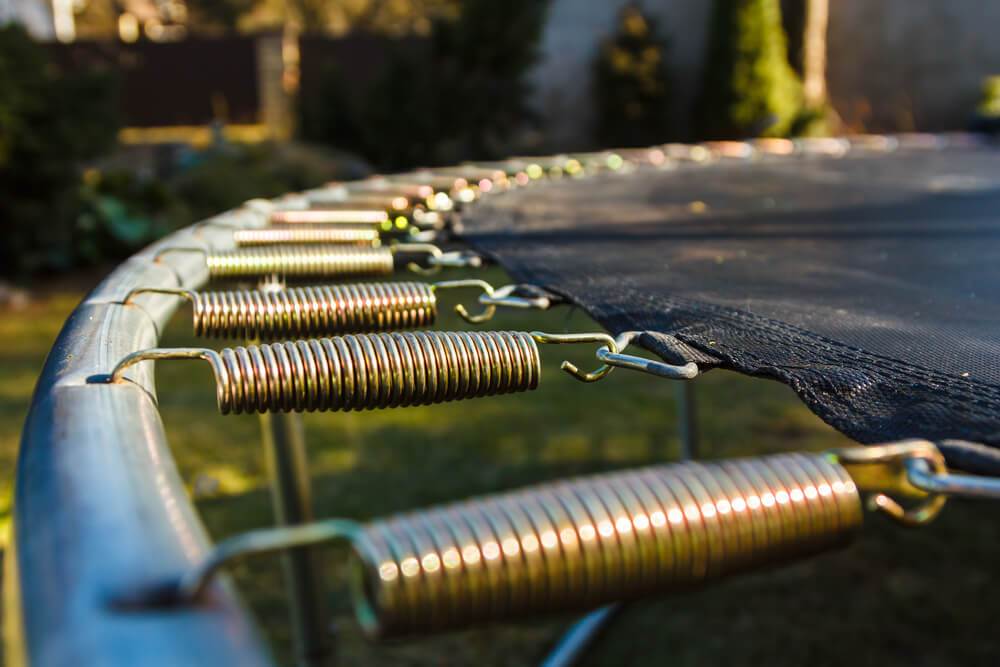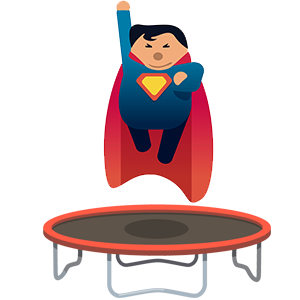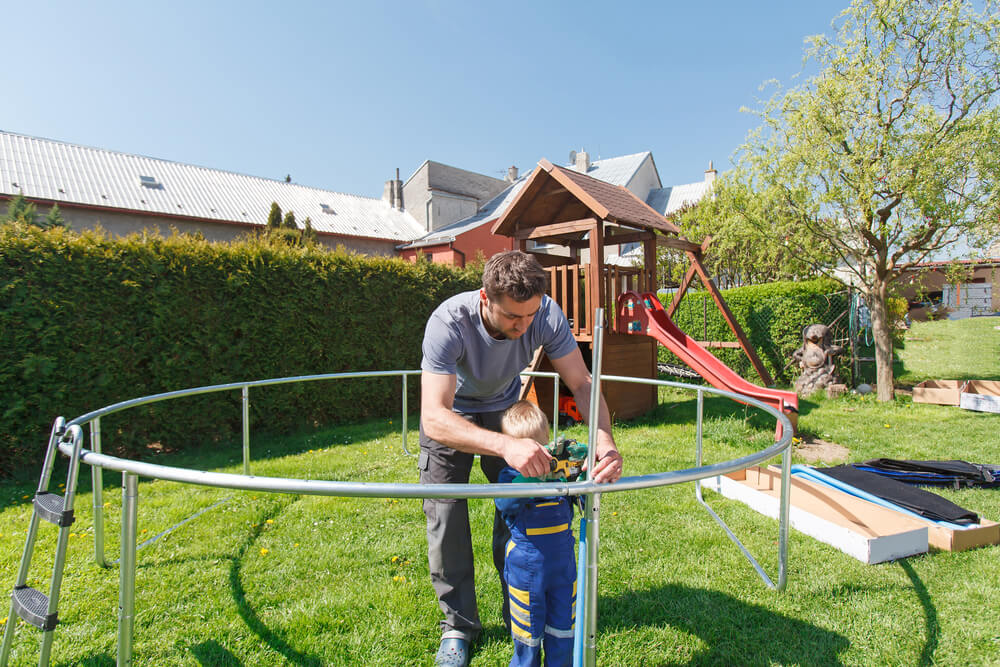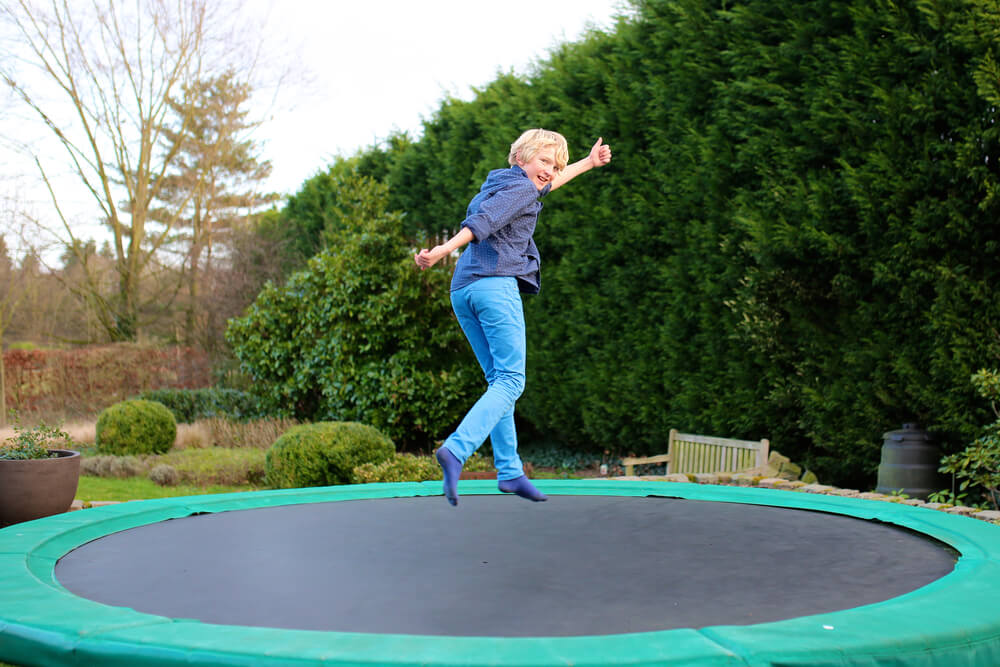Not only does a trampoline spring make your bounce worthwhile, but it also enhances the jumper’s safety and determines the trampoline’s longevity. Read on to understand what to do to optimize the spring’s performance.
The fun of a trampoline is how high it bounces. And when you hear the sound of the spring snapping, then you know you’re in the air.
But the length of the spring determines how far it can stretch. Hard jumpers, such as young teens, using shorter springs can risk cutting the springs from the frame, which can cause falls.
That’s why it’s important to know how far the trampoline spring you or the kids use can stretch.
Here are the answers to the questions our audience keep emailing us:
Does Crossing Springs On a Trampoline Make It Bouncier?
Yes, it does.
It entails arranging the springs to form a pattern that increases their elasticity and strength. The common patterns include patterns V, W, and X.
Pattern V involves arranging two pairs of springs by connecting them to the separate slots on the frame. Nevertheless, the other end of the springs must connect to the rungs to form a V shape.
Pattern W involves connecting the springs to the rung of the jumping mat and adding two more springs by attaching them to the frame by creating a W shape.
Pattern X requires you to place one spring over the other to form an X.
How Can I Make My Trampoline More Bouncy?
Trampolines primarily get their bounce from the springs. Check your springs for rust, broken springs, or lost elasticity if your trampoline has been losing its bouncing capabilities recently.
You can, however, restore a trampoline’s bounce by:
- Crossing springs, as mentioned earlier.
- Use of double spring – This is possible if your trampoline can accommodate more springs. The more the springs, the bouncier the trampoline.
- Use of stronger strings – if you are replacing the springs of your trampolines and want more bounce than the springs offered, consider getting heavier-duty ones. Stronger springs store more kinetic energy that is reflected back at you, meaning more bounce for any user’s jumps.
- Use anchor kits to add extra springs.
How Do You Fix a Stretched Spring on a Trampoline?
The issue of spring overstretching is a relatively new one. Up until the late 1990s, most trampoline manufacturers supplied full-sized trampolines, typically 14 feet in diameter with about 100 springs that were not less than 8 inches in length.
After that era, mass merchants have pressured manufacturers to produce cheaper trampolines with less spring quantity and quality that is prone to overstretching.
When springs stretch out, you will have to replace them. It is advisable to replace springs with the same length; you can add an extra inch in length without compromising safety.
Adding more than one inch increases the chances of touching the ground during jumping as the trampoline height was built with the initial spring length in mind.
While getting the old springs off, ensure the jump mat is not under tension. Wear protective goggles to prevent any mishaps in case they occur. Thick protective gloves are also recommended as springs can be rough, rusty, or shape in the edges.
You can use pliers to force the spring hooks from the loops. Another method is using a spring removing tool. They are T-shaped that unhook springs easily; they can reattach them too. They are convenient and time-saving.
How Many Springs Does a 15-Foot Trampoline Have?
A 15-foot trampoline typically has 96 springs.
It’s not only important to know the number of springs for your trampoline model, but it’s also crucial to know the spring size.
This knowledge comes in handy when replacing the springs due to breaks or cracks.
Can a Trampoline Stretch Out?
With constant use, trampoline springs stretch and lose their elasticity. Other reasons trampolines stretch out are:
- Springs wearing out due to rust
- Worn areas in the jumping mat
- Exceeding the weight capacity of the trampoline
Maintaining your trampoline reduces the chances of stretching out. Carry out routine checks to catch any issues before they become too much. Add more springs if you feel the pre-installed ones don’t give you the desired bounce.
Why Do Trampoline Mats Rip?
Frequent use, harmful UV rays, and cold weather play a part in the wear and tear of the mat.
But there’s a common culprit: damaged trampoline springs. When you bounce on a trampoline with rusty or flimsy springs, the mat may be pulled on one side resulting in wear and tear.
That’s why it’s important to check the springs on a monthly basis to ensure they are sturdy and replace the rusty ones.
Use a cover for your trampoline mat to protect it against weather influence, at least while you are not using it.
You can repair ripped mats using a sewing machine with a UV-resistant thread.
How Far Down Does a Trampoline Go?
In-ground trampolines are growing in popularity and rightly so. There is less than 40% digging when installing an in-ground trampoline due to a retaining wall that sits on a ledge. You will only need a bowl-shaped hole, which means less digging.
You should dig 10 inches of soil uniformly across the entire hole. Then, in the middle, dig an inner hole that is 24 inches less in diameter than the trampoline size in a bowl shape to 36 inches for 12 to 14-foot trampolines. For 8 to 10 foot trampolines, dig to a depth of 30 inches. This forms the ledge upon which the retaining wall sits.
Can an above-ground trampoline be sunk to the ground? Yes, but it could lead to negative safety implications. Their pads are connected such that springs are accessible when you sink it in the ground and get rid of the net.
You will require a deeper hole to accommodate the height of the trampoline. There’s a huge risk that soil might fall away over time that could lead to hitting the bottom when bouncing. Little feet might also get trapped as a gap may appear around the edge of the frame.
In-ground trampolines provide unique vented pads and jump mat that allows free flow of air through the pads and mat resulting in a smoother and better bounce.
Did we mention that in-ground trampolines are safer? This is because there is less distance down in case a user falls off a sunken trampoline and children do not require assistance on and off it.
Just like on-ground trampolines, in-ground trampolines require regular maintenance. You should create drainage beneath the trampoline so water doesn’t accumulate.
Otherwise, moisture could get to the frame, springs, and other metal parts, causing rust. And we all know how rusty springs can cause damage including tearing the mat and causing falls when they break.
What Is The Difference Between Long and Short Springs?
If your trampoline springs are long, it is capable of stretching further. The further it can stretch, the smoother the jump, as it will take longer to transfer energy through your body.
The shorter the trampoline springs, the shorter it stretches; it also means a shorter period to transfer energy through your body; hence a short, stiff, and harsh bounce is felt.
Short springs will, in the end, deform for good because of shortstop rebounds. Short trampoline springs are cheaper, made of lower quality steel, and beat up sooner than longer springs.
Springs shorter than 7 inches are highly disregarded, especially for younger teenagers who weigh more and jump hard. Springs 8 to 10 inches in length are generally recommended as they have a smoother stretch and superior quality.
Can a Trampoline Break?
Yes, a trampoline can break and for different reasons.
The frame may collapse, a screw or bolt can get loose, causing some parts to break.
And after extended use, the springs can overstretch or rust, developing cracks that could eventually cause them to break.
Before buying, check for trampolines made with heavy-duty, galvanized frames sturdy enough to stand the test of time.
Also, please note the weight capacity of your trampoline and don’t exceed it.
How Much Weight Can a Trampoline Spring Hold?
A trampoline’s weight limit depends on the load capacity rating of its springs or the supportive rods used to design the unit.
Exceeding the stated limits can easily break the springs, causing falls and injuries.
Most garden trampolines for children can accommodate 200 pounds and below. On the other hand, toddler trampolines can’t take more than 50 pounds.
There’s a new set of trampolines known as parent/child trampolines. Most of these support 120 pounds and less.
Similarly, adult-based trampolines can support anywhere between 400 and 750 pounds. So, if three adults climb on the trampoline and exceed the required weight, the springs may break.
Based on the size, here are weight limits for trampolines:
- 8 to 10-foot trampolines – 200 to 250 pounds
- 12-foot trampolines – 250 to 300 pounds
- 14 to 16-foot trampolines – 250 to 400 pounds
Weight limits are provided for both safety and operational reasons. A trampoline’s bouncing motion is what makes it worth your time.
Weight plays a crucial role in the scheme of things, as the trampoline needs to match the upward force with the downward force – a function that springs fulfill.
Wrap up
Trampoline springs can stretch but have a limit. If you exceed the trampoline’s weight limit, for instance, they may just break and cause falls or injuries.
Springs determine how bouncy a trampoline is, so it’s best to inspect them often for rust, cracks and other damages then make necessary replacements.
If left unchecked, damaged springs can rip off the jumping mat and cause dangerous falls.
So, while maintaining the trampoline, don’t forget about the springs.
Happy bouncing!







